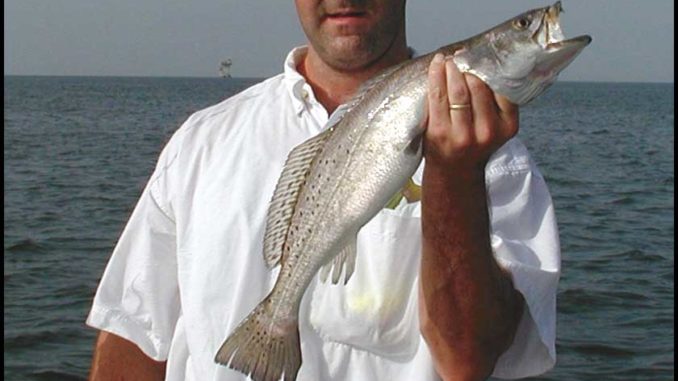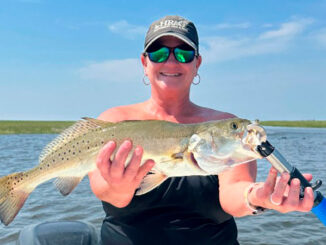
This month, it really takes a whole lot of work to return to a dock on the shores of Calcasieu Lake without a bunch of specks, reds and flounder.
Flyrodders have enjoyed an unusually good summer for speckled trout, mostly along the beaches and in open waters like Breton Sound, Big Lake and Lake Barre. But I’d bet my dog — whose more valuable to me than my house — that speck fishing is going to be better now that fall is here.A whole lot better.
You see, once the water temperature starts to fall, the organic content in the water also drops. That means clearer water, and Cormier’s 2nd Law of Fly Fishing comes into effect: “Clear water favors the fly rodder.”
But until the water gets clear enough where we have the full advantage over the lure chunkers and commie baiters, there’s a few tricks up our sleeves we can use to get those marsh trout to eat flies.
First, let me run down exactly what flies you’ll need.
The mountain trout angler’s adage of “match the hatch” applies to saltwater as well. For example, crab patterns work great for reds, and menhaden imitations are killers for a number of pelagic species.
So it’s no surprise that for speckled trout, you want to have anchovy/minnow and shrimp patterns.
The Clouser Minnow is perhaps the best anchovy imitation of all time. Granted, there are more realistic patterns, such as the Charlie’s Angel, Boylermaker or even the Gummy Minnow. But the sheer numbers of speckled trout taken on Clousers speak for themselves.
Among shrimp patterns, there’s not really one that stands out. Just about any shrimpy-looking fly will work. But for me, the Cinco Shrimp has done more damage than any other. It closely resembles the more popular Goddard Shrimp, so I wouldn’t think the trout care as long as it comes in tan or white and has a little marabou at the bend of the hook (where the eyes are).
Now these flies will catch fish all year round. But in early fall, while the marsh water is still just a bit off-colored, and the specks have already moved in, you’ll need a little lagniappe to get the snaggletooths into your boat.
My friend Jim Thompson has caught good numbers of marsh specks in October using rattle rousers (minnow pattern). The rattle rouser is similiar to Jon Cave’s rattler fly, and as their names imply, the flies have a glass rattle imbedded in a body of mylar tubing, which is then coated with marine-grade epoxy to protect the rattle. If you’ve ever fished a rattle cork, you know that this sound definitely attracts trout.
Popping also attracts fish, which is why two decades ago, Louisiana saltwater flyfishers used a combo “popper and dropper.” The dropper was a sinking fly tied on a section of tippet, usually a foot long, which was then tied to the eye of a surface popper.
Along the way, a bright young man named Cormier — some say a genius, an inspiration to humanity — questioned the use of such a technique, and proposed taking a cigar-shaped perch float, cutting it in half, and making a concave face on each flat end. Realizing that the Nobel Prize committee wouldn’t consider a “flyrodder’s popping cork,” he named it the “vertical oriented strike indicator,” or VOSI as millions now refer to it.
Seriously, I just got plain tired of the entanglements that ensued from casting “popper-droppers.” Not to mention that if you needed to adjust the depth of the fly, you had to cut a new section of tippet and retie knots. I just couldn’t believe anyone hadn’t figured out a simpler way before.
But the bottom line is this: In off-colored water, familiar sounds attract fish. And popping corks, VOSIs, rattles and Speculizers all work for that reason.
Here’s another trick. Suppose in the marsh you find specks busting minnows on the surface. Typically, a pencil popper ideally matches the hatch, but for whatever reason, the trout aren’t giving it much love. Take a VOSI and slip it on about a foot up the tippet. This combo will be harder to cast, but it really does grab their attention. Do try it.
There are two things you need to know about how to fish these flies.
First, if you encounter diving birds, that’s typically school trout. I’ll cast my VOSI-Clouser combo into the area, make a couple of strips to pop the “popping cork” and then let it sit for a few seconds. Usually the trout hit on the sit. If the trout prove to be small, look for banks or structure or even fish the outside areas of the school. These are where the larger trout, if any, will be hanging out.
Second, if the VOSI starts getting strikes, cut off the dropper fly and tie on a popper. Not only is topwater action a whole lot more fun, but the biggest trout in a school are more apt to hit topwater than to hit a fly below the surface.
Tippets
Louisiana Public Broadcasting is now airing “The New Fly Fisher” television series on LPB Plus (cable-only channel that runs in various areas of the state) on Wednesdays at 11:30 a.m. and 3:30 p.m. Set those DVD and VCR recorders because this show, co-produced by the Federation of Fly Fishers (FFF), is acclaimed as the best educational fishing series of all time.
While there’s still lots of fish-catching action, this series focuses on the educational and conservation side of our sport.
Each week, a different topic is addressed, such as how rods are built, the types of fly lines and their purpose, basic casting techniques, etc.
The Camp Fly Fishing School will hold its fall session on Oct. 20-21 in Breaux Bridge. It’s two full days of instruction covering tackle setup, fly casting, knot tying, fly selection, fishing techniques and much more taught by Federation of Fly Fishers-certified casting instructors. Price includes two full days instruction, lunch and refreshments.
For more details or to register, contact Keith or Debbie Richard at (337) 344-0908.


